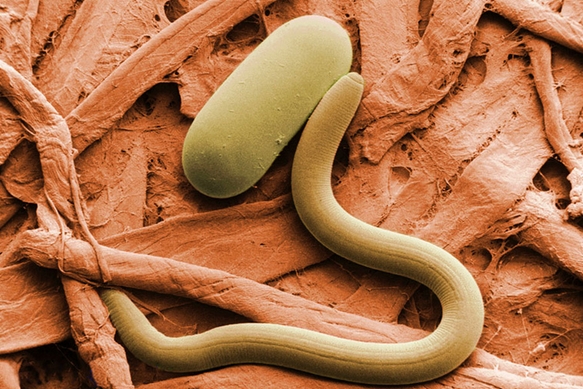Creepy life-threatening parasites straight out of science fiction – only they’re real: Tips for avoiding these 6 nightmares
08/04/2018 / By Janine Acero

It’s easy to avoid dangerous confrontations with large wild animals such as bears and elephants, but what if the danger is lurking just underneath your very skin?
Parasites are among the many microscopic organisms that can penetrate our skin and feed off our flesh and blood. Some of these organisms are so tiny, you won’t feel their presence in your body. However, others are able to make their presence known through blood-curdling symptoms. These “blood-sucking, brain-eating, flesh-boring monsters” inside our bodies cause horrifying diseases as they “find sustenance on the living.” Below are six of these gruesome creatures and some ways on how you can avoid them:
- Brain-eating amoeba (Naegleria fowleri) – This deadly parasite is typically found in warm lakes, rivers, hot springs, warm water runoff from industrial plants, and even filthy swimming pools in the southern states of the U.S. This parasite may infect people who swim in warm bodies of freshwater, but it can also be found in the soil. N. fowleri amoeba infects people through the nose. From the nose, they travel up to the brain, where they eat the brain tissue. The symptoms of N. fowleri infection include headache, fever, nausea, vomiting, and stiff neck, while advanced symptoms include confusion, loss of balance, seizures, and hallucinations. Almost every person to have become infected with this has died. Avoid exposure to this deadly amoeba by holding your nose shut or using nose clips when you go into the water. It is also advisable to avoid digging in or stirring up sediment in potentially infectious bodies of water.
- Candiru “vampire fish” (Vandellia cirrhosa) – You may have heard of the vampire bat, but a tiny catfish from the Amazon River has the same blood-sucking reputation. Also known as the toothpick fish, the candiru measures just three to five centimeters in length, and is a parasite of larger fish, feeding off the blood from their gills. Reports on its attack on humans date back in the 1820’s, with records saying that candiru often swam up men’s penises as the man was urinating in the river, entering the urethra and feeding off the tissue. There are even accounts when the patient’s penis needed to be amputated to get the fish out. There was also one account of candiru entering a woman’s vagina while also in the river. Whether the reports are true or exaggerated accounts of local tribes-people, it is advisable to avoid peeing in the river to prevent any parasitic creature from entering your private parts.
- Filarial nematodes – Filarial worms are parasitic worms in the family Filariidae. Filarial worms are responsible for several infectious disorders collectively known as filariasis, the most common of which are heartworm and elephantiasis. Be wary of traveling to the tropics, where worm-bearing mosquitoes reside; always bring bug repellents, wear long sleeves and pants and sleep under mosquito nets.
- Guinea worm (Dracunculus medinensis) – Found in sub-Saharan Africa, the Guinea worm is a parasite that is transmitted to human hosts by drinking contaminated water from ponds or shallow open wells. The parasites live out their larval stage inside the intestines; the adult worm eventually emerges out of the host’s body, from the feet in most cases. This causes intense pain, blisters, and ulceration of the area where the worm emerged. Avoid this painful experience by drinking filtered water and avoiding stagnant water at all costs.
- Human botfly (Dermatobia hominis) – Don’t confuse this parasitic fly with the relatively harmless bumblebee – the larvae of the human botlfy will infest the skin of mammals and live out the larval stage right under the host’s skin, causing painful pustules. The adult fly deposits its eggs on a blood-sucking host vector, usually mosquitoes or ticks, which then transmit the eggs to the mammalian host when feeding on its blood. The larvae will grow for several months and eventually crawl out of the skin. The human botfly is indigenous from Mexico in the north to Paraguay and northeast Argentina in the south. Don’t forget to bring your insect repellents and mosquito nets when traveling to these areas.
- Toxoplasma gondii – This parasite is the number one cause of food-borne illness in the U.S. Commonly found in undercooked food (especially pork, lamb, and venison) and cat feces, the Toxoplasma parasite causes a disease known as toxoplasmosis. According to the Centers for Disease Control and Prevention (CDC), “more than 60 million people in the U.S. may be infected with the Toxoplasma parasite.” The disease may cause flu-like symptoms, but advanced symptoms include blurred vision and even eye damage. You can prevent exposure from this parasite by cooking your meat properly and changing the cat litter consistently.
We share this planet with all kinds of creatures, including parasites. Avoid exposure to these deadly organisms mainly by staying away from unhygienic places.
.
To learn more about other infectious diseases, head over to Outbreak.news today.
Sources include:
Submit a correction >>
Tagged Under:
amoeba, blood-suckers, filariasis, flesh eaters, how to avoid parasites, infectious diseases, nematodes, parasites, toxoplasmosis, vampire fish, worms
This article may contain statements that reflect the opinion of the author
RECENT NEWS & ARTICLES
Infections.News is a fact-based public education website published by Infections News Features, LLC.
All content copyright © 2018 by Infections News Features, LLC.
Contact Us with Tips or Corrections
All trademarks, registered trademarks and servicemarks mentioned on this site are the property of their respective owners.





















